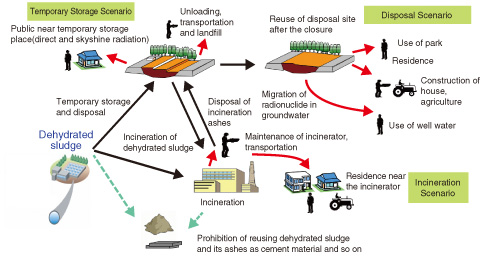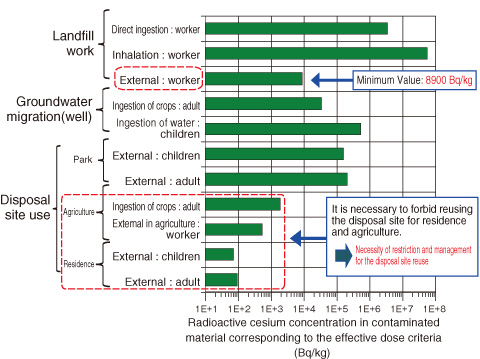
Fig.1-22 Scenarios for incineration and disposal of dehydrated sludge contaminated by radioactive cesium

Fig.1-23 Estimated results of limiting radioactive cesium concentration to ensure safe incineration and disposal
The ground surface environment in Fukushima Prefecture and the surrounding area has been contaminated by radionuclides released from the TEPCO’s Fukushima Daiichi NPS. Soil particles that adsorbed radioactive cesium flow into sewage and water resources for tap water. Dehydrated sludge containing high concentrations of radioactive cesium was generated by sewage and water supply processing. The contaminated sludge should be incinerated and disposed of while ensuring the radiation safety of the workers and the public. However, there was no criterion for treatment of the sludge.
The dose to the workers and the public during incineration and disposal was estimated to provide the technical information for determining the criterion. We calculated the minimum radioactive cesium concentration from the dose results, corresponding to the effective dose criterion indicated by Nuclear Safety Commission of Japan (Near-term policy to ensure the safety for treating and disposing contaminated waste around the site of Fukushima Dai-ichi Nuclear Power Plants, NSC, June 3, 2011).
We focused on the similarity between the actual situation of general incineration and disposal and a series of scenarios in previous clearance level estimation. By incorporating additional exposure pathways peculiar to the sludge into the scenarios based on the clearance level estimation, we could set up comprehensive and reliable scenarios and pathways over a short period of time, as shown in Fig.1-22. According to the information on the actual work conditions and treatment record of the sludge, suitable parameters in each scenario were set for a realistic estimation.
The estimated doses for the main exposure pathways are shown in Fig.1-23. Under the condition of a radioactive cesium concentration of less than 8000 Bq/kg, general incineration and disposal of the sludge is justifiable under the restriction that disposal site reuse be limited to residential and agricultural use.
This result was used as technical information for determining the criterion for sludge treatment by the Ministry of Land, Infrastructure, Transport and Tourism.